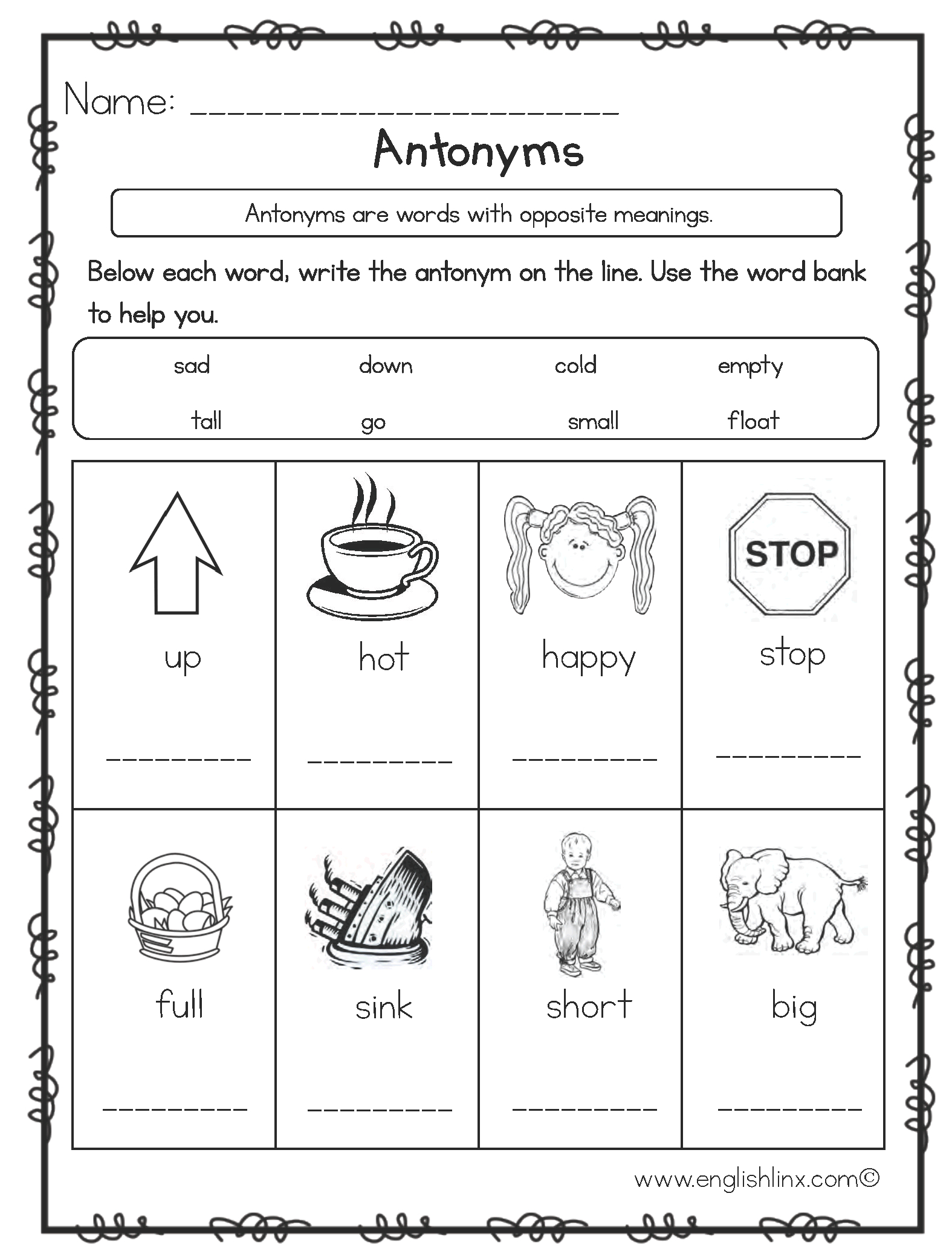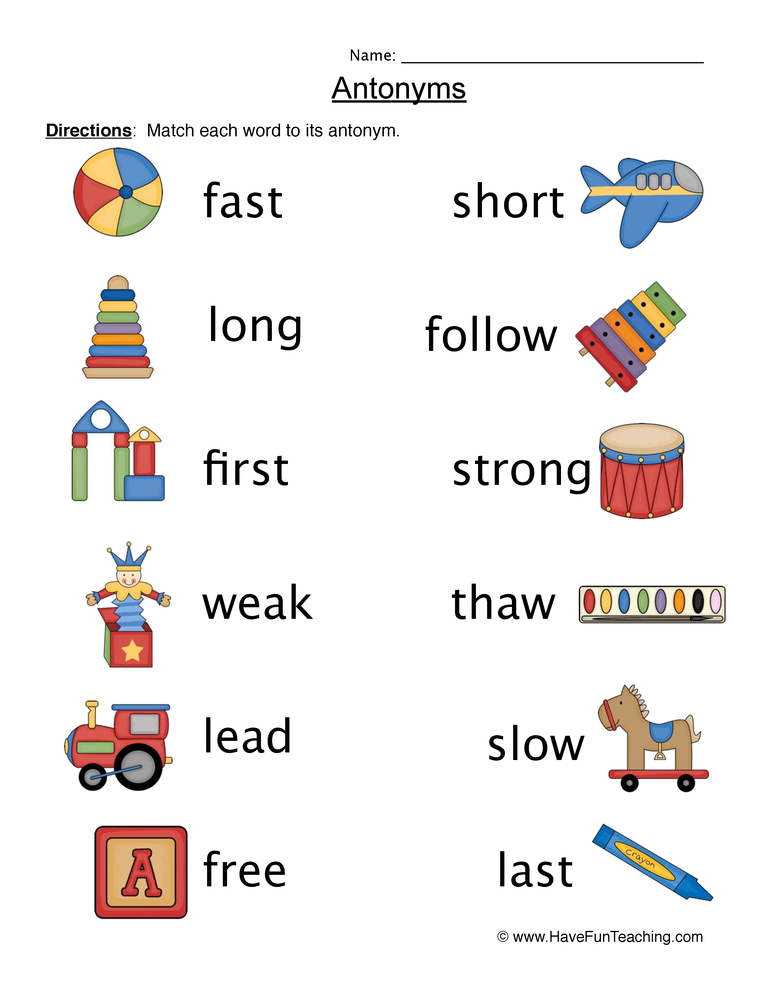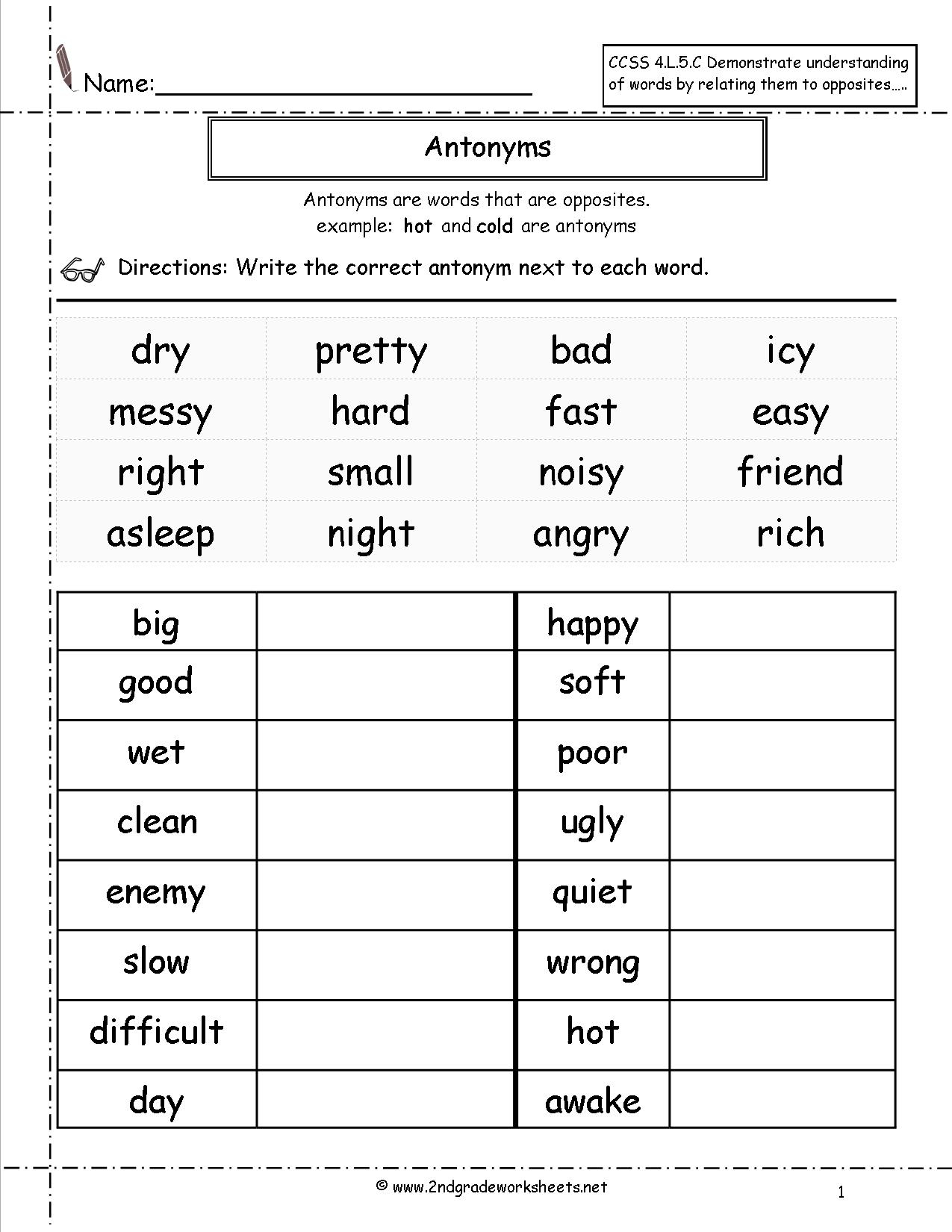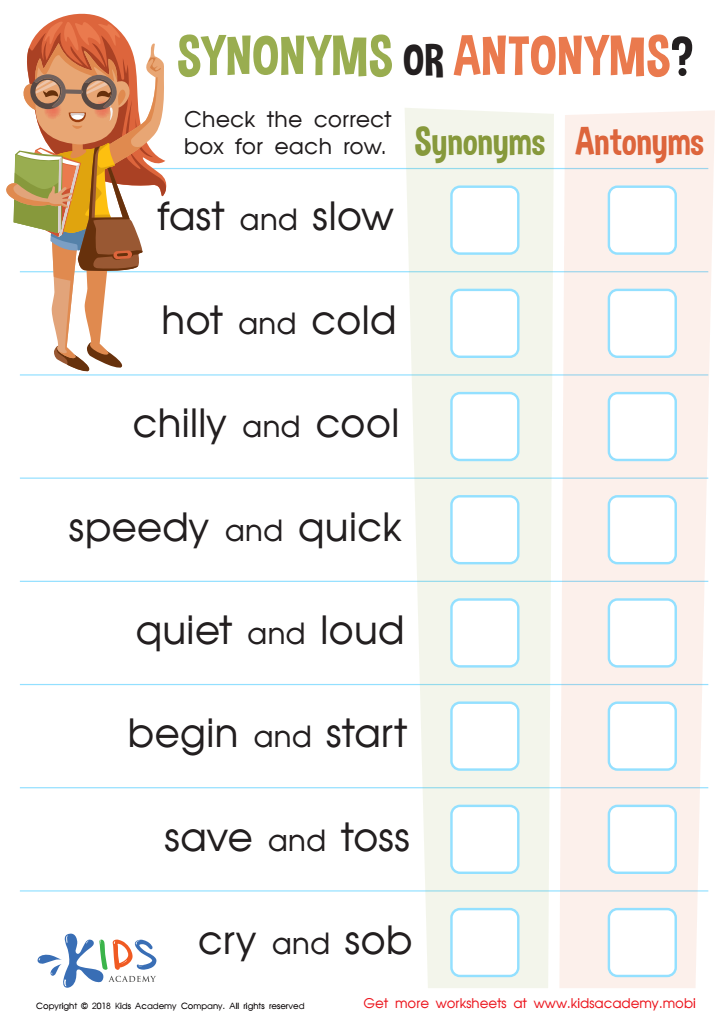
Mastering Vocabulary: The Indispensable Role of Antonyms Worksheets
Language is a vast, intricate tapestry, woven with threads of words, meanings, and relationships. For learners of all ages, from early childhood to advanced language acquisition, mastering vocabulary is a cornerstone of effective communication, critical thinking, and academic success. Among the many tools available to educators and parents for this crucial task, antonyms worksheets stand out as particularly effective and versatile. These structured learning aids provide a systematic approach to understanding word relationships, enriching vocabulary, and enhancing comprehension skills.
This article delves into the profound importance of antonyms in language learning, explores the diverse formats and benefits of antonyms worksheets, and offers practical guidance on designing and implementing them to maximize their impact on vocabulary development.

The Foundation: Understanding Antonyms and Their Significance

At its core, an antonym is a word that means the opposite of another word. Simple examples include "hot" and "cold," "up" and "down," or "fast" and "slow." However, the concept extends beyond simple binary oppositions. Linguists often categorize antonyms into different types:

- Gradable Antonyms: These exist on a spectrum, allowing for degrees between the two extremes (e.g., "hot" and "cold" can have "warm" or "cool" in between).
- Complementary Antonyms: These represent absolute opposites where there is no middle ground (e.g., "alive" and "dead," "true" and "false").
- Relational Antonyms: These describe a relationship from opposite perspectives (e.g., "teacher" and "student," "buy" and "sell").


Understanding antonyms is far more than a linguistic exercise; it is fundamental to developing a nuanced grasp of language. Knowing a word’s opposite helps learners:
- Deepen Semantic Understanding: By contrasting a word with its opposite, learners gain a clearer and more precise understanding of its meaning and the context in which it can be used.
- Enhance Reading Comprehension: Recognizing antonyms in text helps readers infer meanings, understand contrasts, and grasp the author’s intended message more accurately.
- Improve Writing Skills: A rich vocabulary, including a strong command of antonyms, allows writers to express ideas with greater precision, create vivid descriptions, and introduce contrast effectively.
- Boost Critical Thinking: Identifying antonyms encourages learners to think about relationships between concepts, categorize information, and make logical connections.
- Facilitate Word Recall: When a learner struggles to remember a specific word, thinking of its opposite can often trigger its recall, strengthening neural pathways for vocabulary.




Given this foundational importance, finding effective methods to teach antonyms becomes paramount. This is precisely where antonyms worksheets prove their invaluable worth.
The Power of Antonyms Worksheets
Antonyms worksheets provide a structured and systematic approach to vocabulary acquisition that caters to various learning styles. They offer repeated exposure and practice, which are essential for solidifying new knowledge. The benefits of incorporating these worksheets into a curriculum are manifold:
- Structured Practice: Worksheets offer a clear, step-by-step format for learners to engage with new vocabulary. This structured environment reduces cognitive load and allows learners to focus on the task at hand.
- Reinforcement and Repetition: Consistent practice with antonyms through worksheets reinforces memory and helps move new words from short-term to long-term memory.
- Visual Learning: Many worksheets incorporate visual elements, such as pictures or diagrams, which can significantly aid comprehension and retention, especially for visual learners.
- Self-Assessment and Immediate Feedback: Well-designed worksheets often come with answer keys, allowing learners to check their work independently and immediately identify areas where they need more practice. This fosters autonomy and self-correction.
- Differentiation: Worksheets can be easily adapted to different proficiency levels, from basic matching for beginners to more complex sentence completion or creative writing tasks for advanced learners.
- Engagement and Motivation: When designed thoughtfully with varied activities and engaging visuals, worksheets can make learning vocabulary a fun and interactive experience rather than a tedious memorization task.
- Foundation for Advanced Language Skills: A strong grasp of antonyms built through consistent worksheet practice lays the groundwork for understanding more complex linguistic concepts like nuance, irony, and rhetorical devices.
Types of Antonyms Worksheets
The versatility of antonyms worksheets lies in the diverse range of formats they can take, each designed to target different aspects of vocabulary learning:
-
Matching Exercises: This is perhaps the most common and fundamental type. Learners are presented with two columns of words and must draw lines connecting each word to its antonym. Variations include matching words to pictures that represent their antonyms.
- Example:
- Hot —- Cold
- Big —- Small
- Example:
-
Fill-in-the-Blanks: Sentences are provided with a missing word, and learners must choose the antonym of a given word to complete the sentence meaningfully.
- Example: The sun rises in the east and ____ in the west. (opposite of "rises") -> sets
-
Multiple Choice Questions: Learners select the correct antonym from a list of options. This format helps in recognizing antonyms within a set of distractors.
- Example: What is the antonym of "happy"?
a) joyful b) sad c) glad d) cheerful
- Example: What is the antonym of "happy"?
-
Sentence Completion/Construction: Learners are given a word and asked to use its antonym in a new sentence, or to rewrite a sentence using an antonym to change its meaning.
- Example: Rewrite the sentence using the antonym of "full": The basket was full of apples. -> The basket was empty of apples.
-
Word Search and Crossword Puzzles: These add a gamified element. In a word search, learners might search for pairs of antonyms. In a crossword, clues could be given as words, and the answer would be their antonym.
-
Categorization and Sorting: Learners sort words into categories based on whether they are antonyms of a given word, or they might sort pairs of words into "antonyms" and "not antonyms."
-
Creative Writing Prompts: More advanced worksheets might provide a list of antonym pairs and ask learners to write a short story, poem, or paragraph that incorporates them to create contrast or highlight a theme.
-
Picture-Based Activities: For younger learners or visual learners, worksheets can feature images where learners identify the antonym relationship (e.g., a picture of a full glass next to an empty one).
Designing and Implementing Effective Antonyms Worksheets
The effectiveness of antonyms worksheets hinges on their design and how they are integrated into the learning process. Here are key considerations for educators and parents:
- Age and Skill Appropriateness: Ensure the vocabulary level and complexity of tasks match the learners’ cognitive and linguistic abilities. Start with common, concrete antonyms for beginners and gradually introduce more abstract or nuanced pairs.
- Clear Instructions: Instructions should be concise, unambiguous, and easy to understand, possibly with an example provided.
- Variety is Key: Avoid monotony by incorporating different types of exercises within a single worksheet or across a series of worksheets. This keeps learners engaged and caters to diverse learning preferences.
- Contextualization: Present antonyms within meaningful sentences or short paragraphs rather than just as isolated words. This helps learners understand how the words are used in real-world contexts.
- Visual Appeal: Use clear fonts, ample white space, and relevant graphics or illustrations to make the worksheets inviting and easy on the eyes.
- Scaffolding: Introduce new concepts gradually. For example, provide a word bank for fill-in-the-blanks initially, then remove it as learners progress.
- Feedback Mechanisms: Always provide an answer key or plan for timely review and feedback. The learning happens not just in completing the worksheet, but in understanding what was correct and why.
- Integration with Other Activities: Worksheets should not be standalone. Use them as a prelude to discussions, games, reading passages, or writing assignments that further reinforce the antonyms learned. For instance, after completing an antonym worksheet, challenge students to use some of the pairs in a descriptive writing piece.
- Make it Fun: Incorporate elements of play, such as riddles, puzzles, or competition, to make the learning experience enjoyable.
Beyond the Worksheet: Integrating Antonyms into the Curriculum
While antonyms worksheets are powerful tools, they are most effective when part of a broader, holistic approach to vocabulary development. Educators should strive to integrate antonym learning into various aspects of the curriculum:
- Daily Discussions: Encourage students to describe things using antonyms ("Is the water hot or cold?").
- Reading Aloud: Point out antonyms in stories and discuss their impact on the narrative.
- Vocabulary Games: Play games like "Antonym Charades" (act out a word, and others guess its antonym) or "Antonym Memory" (match pairs of antonyms).
- Writing Prompts: Challenge students to write stories where characters or settings are described using contrasting antonyms (e.g., a tall, dark building next to a short, bright one).
- Concept Mapping: Create visual maps where a central word is connected to its synonyms and antonyms.
- Digital Tools: Utilize online quizzes, interactive games, and vocabulary apps that often feature antonym exercises.
Conclusion
In the journey of language acquisition, vocabulary development is a continuous and vital process. Antonyms, as fundamental building blocks of meaning and contrast, play an indispensable role in this journey. Antonyms worksheets, when thoughtfully designed and strategically implemented, offer a highly effective, versatile, and engaging method for learners of all ages to master these crucial word relationships. They provide the structured practice, reinforcement, and self-assessment opportunities necessary to deepen semantic understanding, enhance communication skills, and foster a lifelong love of language. By leveraging the power of antonyms worksheets, educators and parents can equip learners with the linguistic agility needed to navigate and express themselves effectively in an ever-complex world.
